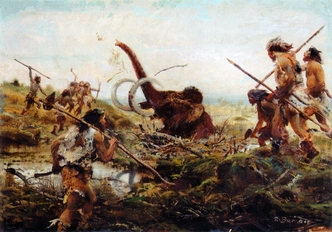Ever wonder how natural instinct aided in our species’ remarkable triumph against the endless dangers of the Paleolithic Age? We should not underestimate the amazing feat of our ancestors’ success in overcoming the scarcity of vital resources and their ability to withstand traumatic encounters with treacherous wildlife. With that in consideration, our predecessors’ ability to analyze, adapt, and overcome obstacles ultimately resulted in the prosperity of our species.
In our most adolescent years of species development, our ancestors established unique methods in conquering the colossal tasks of surviving in the Stone Age. To compensate for their small structure, Paleolithic hominids used simple resources to craft efficient weapons, and applied their intelligence to create impeccable coordinated attacks. Studying the individual and group behavior of their prey enabled our prehistoric hunters to discover new hunting strategies. Through critical thinking, it influenced their decision in choosing the best time to strike their prey so as to ensure positive outcomes from their attacks.1 Their persistence, planning, and effort resulted in the recurrent and inevitable demise of their prey. The types of animals that were chosen in hunts often depended on their size and aggressiveness. In order to continue providing for the hunter-gatherer community, hunters kept wary of the possible risks that came with hunting dangerous animals with dangerous reputations, such as Woolly Mammoths, Woolly Rhinoceros, and Cave Lions. Hunters invented ranged weapons in order to compete with their prey, which changed the necessity of close contact with these large beasts, and really opened up their options in creating more intuitive attacks. This new method of ranged hunting allowed them to attack from safe distances, and ultimately minimized the dangers that came with hunting more rewarding animals.
Hunters were assigned different types of weapons depending on the body type and size of the hunters. This method was established to maximize damage efficiency and control over the advantageous weaponry. Spear throwers were usually tall hunters with proportionally longer arms, which gave them greater leverage and control. Smaller hunters typically used bow and arrows, which did not require long arms, and their training allowed them to master this much more precise and sophisticated approach.2 Attacking in large hunting groups allowed hominins to overwhelm and defeat their much larger prey. Hunting larger animals came with greater risks, but the possible rewards and resources that were obtained through conquering these enormous animals balanced out the possible fatalities: the bigger the risk, the bigger the reward.3

Some of the weapons utilized in these prehistoric encounters were primitive tools made from the simplest materials such as rocks, sticks, and bones. Although wood was much available, bone was preferred when due to its density, strength, and the convenience in being to able to mold it easily. Hominins used animal bones to create spear tips and arrows that would last much longer than the original method of using wooden spear tips.4 Through their inexpensive and useful resources, they were able to create effective hunting tools in small amounts of time, resulting in the discovery of the traditional throwing spear, the bow and arrow, and hunting traps. Their innovative weapons were designed to incapacitate a great variety of animals, and did so with much more efficiency.
Through the astounding accomplishments and efforts of our ancestors, their revolutionary inventions and mental growth has allowed us to thrive in our world, and has helped us develop into the dominant species we are today. Without our ancestors abilities to strategize, coordinate, and desire to survive, our existence would have been wiped off the face of this Earth many million years ago.
- Gerrit Leendert Dusseldorp, “Studying Prehistoric Hunting Proficiency: Applying Optimal Foraging Theory to the Middle Paleolithic and Middle Stone Age,” Quaternary International, 252 (February 2012): 4. ↵
- David W. Frayer, “Body Size, Weapon Use, and Natural Selection in the European Upper Paleolithic and Mesolithic,” American Anthropologist 83, no. 1 (1981): 58. ↵
- Mary C. Stiner, “An Unshakable Middle Paleolithic?,” Current Anthropology 54, no. S8 (2013): 289-290. ↵
- Marina Évora, “Osseous Industry and Exploitation of Animal Resources in Southern Iberia during the Upper Palaeolithic,” Quaternary International, 318 (December 18, 2013): 36-38. ↵



37 comments
Khoa Tran
Very Informative! What a tough “age” to live, the Paleolithic Age, where survival is the game. It is very fascinating to know that our ancestor were able to analyze, adapt, and overcome obstacles in order to sustain and survive in a world where vital resources are scarce. The innovation in tools like spear, bow and arrow has helped us develop to a modern world today.
Tyler Sleeter
Excellent article with lots of great information. Our ancestors from the Stone Age were clearly very intelligent and made great use of the things they had to survive. They were able to make weapons that allowed everyone to contribute to their community no matter their limitation. Stone Age communities could survive only as long as they could hunt successfully and, of course, make use of the animals they killed. Clearly our ancestors were more then just typical “cave-men.”
Ernie Sano
It is apparent that early humans found a way of survival that ensured a continued existence. Revisiting this concept allows for a better understanding of what exactly has aided in the progression of humanity. While the subject matter may be seen as outdated or unimportant to some, the idea behind the article centers on the amazing and seemingly boundless creativity that the world has almost forced upon humanity. It follows the notion that ingenuity is a constant in human evolution, which will only advance to greater heights as time passes.
Ana Gonzalez
Nice article! I agree that our ancestors were very clever in creating weapons and using the resources they had to hunt. If they had not used sticks and stones and carved out arrows, they most likely would not have survived all those harsh years. The one motive that drove our ancestor during the stone age to do anything was survival, it’s unbelievable how things change. Your article was very informative and engaging. Great job!
Cameron Mays
This is a very interesting topic, as the hunting that occurred here basically set the foundation for all the hunting of the future, and just the sheer thinking of hunting with tools is super cool as it sets humans a part from basically every other animal. With that said, your opening sentence was quite weak; asking a question like that is somewhat redundant as the reader already clicked on your article based on your title and picture, you need something else to hook them in and keep them reading.
Steven Clinton
Great article, the hunters of the stone ages were phenomenal athletes; rightfully so, the hunters had to be to succeed in their hunts. The hunters of the stone ages develop tactics and coordination through their hunts. Some of the tactics that are ancestor thought of are still being used today, not just hunts but also in warfare. I look forward to your next work!
Nicolas McKay
This was terrific article Joshua! I was greatly interested by the technical, almost scientific approach to your writing, which was most evident in your opening paragraph. You took what is normally viewed as simple cavemen hunting and turned it into a scientific analysis of their habits and strategies. Very well written, well done once again.
Alyssa Vela
This was a really interesting article! It’s crazy to think that at some point in time getting a means for survival as simple as food was so challenging! I thought it was so interesting how people were given specific weapons based on their physical attributes(size) and their skills. Overall this was an amazing article! Thanks for the enlightenment, I look forward to reading more of your work!
Erick Paul Martinez
Awesome article, you organized your thoughts very well. This was a real eye-opener for me, I never took time to think about all the adversity our early ancestors endured. I thought it was really cool how hunters were assigned their tools/weapons based on their body type. It demonstrates how smart they truly were and how they managed to survive.
Mario De Leon
I was interested in this article because I don’t know how our ancestors survived those difficult times. I knew they used spears and arrows but I did not realize how much strategy they put into the hunt. I was interested in the fact that weapons were assigned by physical characteristics. For example, a tall man with long arms would usually be assigned a spear.